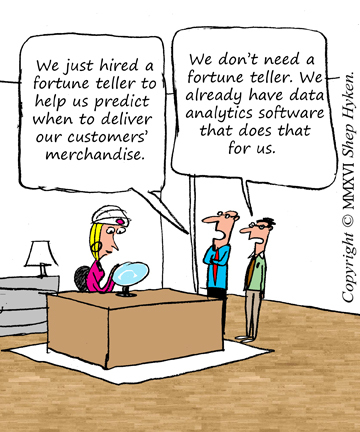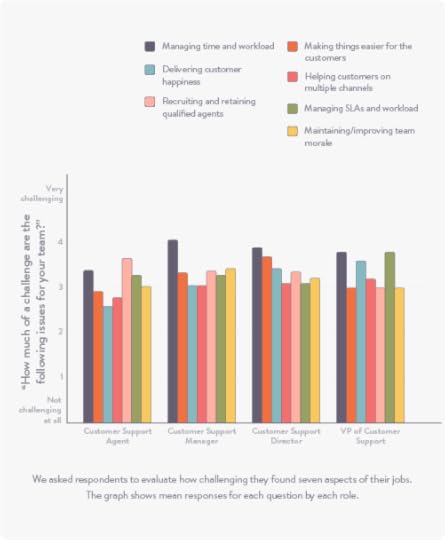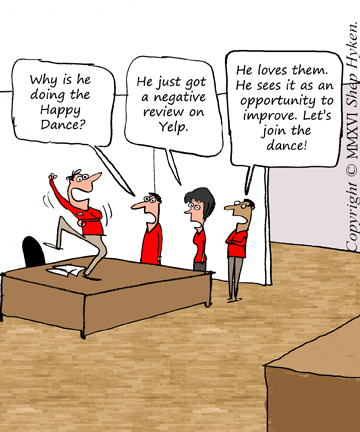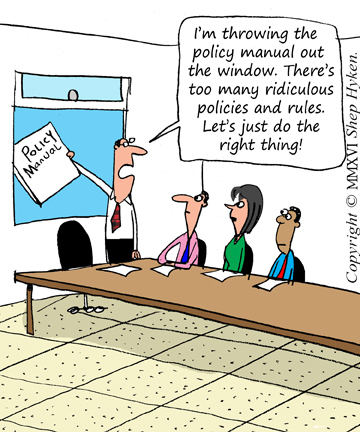Shep Hyken's Blog, page 194
February 24, 2016
Set It, and Forget It: A Powerful Customer Service Strategy
 Easy Customer Experience
Easy Customer Experience“Set it, and forget it!” Those are the words of Ron Popeil, one of the greatest pitchmen on the planet, known for inventing and selling the Chop-O-Matic hand food processor, the Veg-O-Matic (that he said can slice a tomato so thin it only has once side), the Ronco Pocket Fisherman and many other inventions. His Showtime Rotisserie and BBQ sold over 8 million units and helped his company to exceed $1 billion in profits. (Wikipedia)
One of the lines he made famous was, “Set it, and forget it,” referring to just putting the chicken in the rotisserie and having it come out perfect every time. And, that is the lead in to this week’s customer service lesson.
“Set it and forget it” is about being easy. It’s about convenience. It’s all about a frictionless customer experience. It’s about having so much trust in the company that you can just “forget it.”
Amazon is one of the companies that has figured out this concept. One of their latest programs is the Amazon Dash Button. If you are running out of detergent, soap, razor blades, certain food items and more, you literally push a button that is connected to your home’s WIFI system and, almost like magic, in just a couple of days (or less) your order shows up at your doorstep. Once it is set up, it really is as easy as just pushing that button. Amazing!
But wait, there’s more!
Amazon has taken this to another level. They have partnered with several companies, with many more to come, that will sense that you’re running low on items such as detergent for the washing machine or ink for your printer. Without even having to push the button, the merchandise just shows up. The machine actually places the order for you. Now, that’s Amazing on steroids!
I’ve written articles and created videos around the concept of predictive analytics. A customer’s consistent buying pattern allows the retailer to predict when the customer will come in. For example, you may buy dog food at the same time each month. The progressive retailer will arrange to deliver the dog food to your doorstep until you say to stop. Once you set it up with the retailer, you can forget about it. It will just happen, automatically, like clockwork.
This applies to just about any consumable that a customer buys on a regular basis: food, clothes, prescription drugs and much more.
Whether it’s a customer’s predictive buying pattern or amazing technology that sends signals to Amazon (or any other retailer) to have merchandise delivered just before it runs out, the concept of set it and forget it is easy and invisible – an experience that the customer will appreciate.
Shep Hyken is a customer service expert, keynote speaker and New York Times bestselling business author. For information contact or www.hyken.com. For information on The Customer Focus™ customer service training programs go to www.thecustomerfocus.com. Follow on Twitter: @Hyken
(Copyright © MMXVI, Shep Hyken)
The post Set It, and Forget It: A Powerful Customer Service Strategy appeared first on Shep Hyken.
February 23, 2016
Amazing Business Radio: Mark Hunter
 Mark Hunter on How to Be a Great Leader
Mark Hunter on How to Be a Great Leader
Shep Hyken discusses leadership with Mark Hunter, The Sales Hunter, keynote speaker, author, and sales trainer. Mark explains the differences between managing and leading, sharing great examples on how leading makes a better impact than managing. If you are an entrepreneur or involved in any management role, this show has some great insights on how to lead your team.
Click here to listen and subscribe to Amazing Business Radio on iTunes.
“Managers manage an activity, leaders lead the people.” – Mark Hunter
The post Amazing Business Radio: Mark Hunter appeared first on Shep Hyken.
February 22, 2016
5 Top Customer Service Articles For the Week of February 22, 2016
Each week I read a number of customer service articles from various online resources. Here are my top five picks from last week. I have added my comment about each article and would like to hear what you think too.
Twitter’s New Customer Service Features Make It Easier To Send Private Messages And Feedback by Anthony Ha
(TechCrunch) If you’re the kind of person who likes to talk to businesses on Twitter, the company is rolling out some new options to improve those interactions.
My Comment: I’m a big advocate for social media customer care. Customers have been using Twitter as a way to broadcast their complaints or to try and get the attention of the company. Twitter has figured out how to improve the communication with a way for companies to take a public conversation private. And more than just dealing with complaints, it’s also a way to get feedback.
5 Tips to turn BoH staff into customer-experience superheroes by Jason Ryyken
(Fast Casual) Training is critical these days, especially in light of changing demographics among your labor force and customer base. Expectations are rising among customers and employees, while the labor pool is shrinking. Restaurant design is changing, too, with open kitchens exposing equipment and employees to the customer.
My Comment: Customer service concepts are universal. This article focuses on how to turn employees of a restaurant into customer-focused “super-heroes.” While a bold concept, any business can use some of these ideas. My favorite is #1: Throw out the book! And my next favorite is #3: Win over your employees, and they will win over your customers.
Meet the Man Behind the Best Men’s Clothing Store in America by Will Welch
(GQ) The GQ 100—our big list of the best places for a man to shop—isn’t a competition, exactly. But if we if we had to declare a winner, it would be this guy, Sid Mashburn. Not only did the Atlanta-based designer’s game-changing tailoring destinations top our list of the 10 best shops in the country, he also just celebrated the opening of his third store, in D.C., and his fourth, in Dallas. So we got Mr. Mashburn, a man who is just the right mix of rebellious and genteel, on the horn to talk about how to change a car battery in a suit—and what lucky American city he’ll cut the ribbon on next.
My Comment: There is a lot that any business can learn about from a men’s clothing store. Sid Mashburn’s retail store is the top men’s clothing store in America, and he shares the story of his success, which includes plenty of examples of customer service. I’m not surprised!
4 Types of Difficult Customers on Chat and How to Deal with Them by Olga Kolodynska
(LiveChat) Here’re 4 types of difficult customers explained using situations that happened during our chats. Plus, advices on how to deal with them.
My Comment: I can’t imagine a business that hasn’t encountered all of these types of “difficult customers” and others. While the article focuses on how to deal with them through chat, I think the responses are appropriate through virtually any type of communication, from online to in-person.
Welcome to the Success Economy by Tod Ebby
(Success Hacking) It goes without saying that we’ve entered a new age when it comes to the customer. The Software as a Service (SaaS) model, moved the customer into the driver seat, and they are not going to give it up.
My Comment: The concept of Customer Success is growing. Help make your customer a success with your product, and they buy more, buy more often and may even become loyal. Isn’t that what we want. When what you do helps make a customer successful, they may return the favor with more business, which makes you more successful.
Shep Hyken is a customer serv ice expert, professional speaker and New York Times bestselling business author. For information contact or www.hyken.com . For information on The Customer Focus™ customer service training programs go to www.thecustomerfocus.com . Follow on Twitter: @Hyken
The post 5 Top Customer Service Articles For the Week of February 22, 2016 appeared first on Shep Hyken.
February 19, 2016
Guest Blog: Customer Delight Is Unnecessary in the Era of Multichannel Support
This week on our Friends on Friday guest blog post my colleague, Adam Rogers writes about the growth of multichannel support and how to focus on providing effective support wherever the customer is asking for it. It is important to provide customers with a consistent, predictable experience when they reach out. – Shep Hyken
For many companies today, going above and beyond and achieving customer delight is at the top of the agenda for their support teams. But is this sustainable, or even an effective, use of support efforts?
The arrival of multichannel support is beginning to see customers’ priorities change, from seeking delight to wanting a response “here, and now.” And this should impact the way that companies look to deliver support.
A new study by Kayako on the state of the customer support profession in 2016 looked into the priorities and challenges that support professionals face. It found that support teams currently prioritize customer delight over multichannel support, but find their workloads difficult to manage.
It’s predicted that multichannel support will be the biggest change to hit the support profession in 2016. Support teams are going to face even heavier workloads as they have more channels to manage and higher expectations from customers to match.
Now is the time for business leaders to let go of the idea of customer delight and free up their support teams to focus their efforts on multichannel support.
Customer delight is unnecessary
With multichannel support taking off in 2016, now is the perfect time to recognize that customer delight is not a scalable option.
Research supports this too: aiming to exceed the customer’s expectation during a service interaction only makes them marginally more loyal than simply meeting their needs. Shep Hyken echoed this sentiment as a guest on the Crack the Customer Code podcast:
“You can’t wait for problems to happen to be amazing all of the time. For the occasional problems; the bumps in the road, the opportunities you find to go over the top – seize those. But for the other 98% of the time you should be operating a little above average. The consistent, predictable experiences is what makes great companies amazing.”
Soul of Brand’s 2012 research found that more consumers would recommend a brand that provides a quick but ineffective response over a brand that provides a slow but effective solution.
This shows that support teams should stick with providing customers with the support they require in good time, rather than aiming for delight in every interaction.
Delivering customer happiness is easy
According to Kayako’s study, 73% of support professionals already find managing time and workload the most challenging part of their role. That’s without the full force of multichannel support added to their workload.

Multichannel support is being able to provide support in more than one channel from a single helpdesk. This makes sure that all conversations are tracked and converted to tickets when necessary. This means if a customer is on the phone, and has previously emailed about the same issue before, it will be really easy for the agents to pull up your inquiry.
The main support channels are email and telephone, with live chat and self-service (help centers, FAQs and forums) rising in popularity in recent years as customers seek lower effort options.
Now, customers see Facebook and Twitter as support channels too, and social media support comes at a price. Research by Edison found that, 42% of consumers expect a response on social media within one hour, and 32% think it should be within 30 minutes.
Imagine the backlog of support inquiries this would produce if support agents aimed for delight in every interaction. This would only add to the growing challenge of managing their time and workload.
Prepare your support team for multichannel support
Expecting your support team to aim for perfection in every interaction while increasing the number of ways your customers can seek help is unrealistic, and will likely lead to burnout in your support team. Instead, investment into the right areas of customer support is vital.
There are ways to reduce the impending load that will hit front-line support professionals this year. Create an excellent self-service offering, so busy customers can help themselves. This takes extra pressure off your support team by reducing the volume of requests that come in.
Invest in things that can reduce the workload for your support team like hiring more support agents, and training and coaching your team. Consider investing in better helpdesk software, because a truly multichannel helpdesk will bring everything together and make support easier for the agents and your customers.
This is where business leaders need to take note, and recognize that it maybe time to adjust their expectations for customer support. With the sheer amount of support interactions set to increase this year, customer delight will only become more time consuming. Under the added workload and backlog of support interactions, your support team may end up burned out.
With multichannel support on the horizon, customer interactions will grow and the quality of support could suffer. Business leaders can take action now by reducing customer effort, and focus on delivering customer delight on a larger scale, rather than an individual customer basis.
Take a look at the four new facts about the customer support industry in the slideshare below, and you can read the full 30-page report here.
Four Revealing Insights into the Customer Support Industry for 2016 from Kayako
Adam Rogers is a writer, digital marketer for Kayako . He loves helping customers get better at customer service. All of Adam’s writing on customer service and startups is available on the Kayako blog . You can connect with him on LinkedIn, Twitter @adamrogersuk and his personal site .
For more articles from Shep Hyken and his guest contributors go to customerserviceblog.com .
Read Shep’s latest Forbes Article:
It’s Valentine’s Day: Show Your Customers A Little Love
The post Guest Blog: Customer Delight Is Unnecessary in the Era of Multichannel Support appeared first on Shep Hyken.
February 17, 2016
Embrace the Negative Review
 Online Customer Reviews
Online Customer ReviewsNobody is perfect. And, no company is perfect. It’s not a matter of if you will ever have a customer complain. It’s when. Something is going to fail. It may or may not be your fault or in your control, but you are going to hear about it. And there is a chance that your customer will tell more people than just you. They will shout it out to the rest of the world by airing their disappointment on Twitter, Facebook or other social channels. Or they will post their comments on Yelp, Trip Advisor or other review sites. And don’t think that this is limited to just B2C types of businesses. There are hundreds of B2B industry review sites for customers to leave their negative reviews.
All that said, a negative review is not so bad. I’ll give you two reasons.
First, I’ll assume that you don’t get that many negative reviews. I know this is a big assumption, but I have to assume that if you’re taking the time to read my articles and watch my videos, you are focused on creating a positive customer experience. What that means is that you care enough about a customer that is disappointed or angry that you want to “right the wrong.” If a negative review is posted, the good companies respond with an apology and make the attempt to fix the problem. They come back later and thank the customer for the opportunity to resolve the issue. That publically shows that you do the right thing. It looks good and shows you care and will stand behind what you do or sell.
A less than perfect score in the review sites with a few negative comments may not be so bad. What I’m saying is that an occasional, and occasional is the operative word here, negative review can actually be good. Tom Ryan, writing for RetailWire, shared some insights from a recent Northwestern University study. On the five star scale, when the star ratings are higher than three, the likelihood of a customer buying increases. But here is where it gets really interesting. That likelihood of a purchase peaks when the average star rating is, on average, between 4.2 and 4.5. The team conducting the study at Northwestern reasons that when the average is a perfect 5.0, consumers think that it is “too good to be true” and as a result, ignore the ratings because they are assumed fake.
Here is the bottom line. A negative review, like any complaint, is an opportunity to show how good you are. The difference is that review sites take that opportunity public, which can be good; very good!
When people are looking at review sites, they are looking for confidence to support their desire to buy whatever you’re selling. Peer reviews are important. Seeing that a company fixes a problem may be even more important. Embrace the negative review as the opportunity to show the world that you take care of your customers!
Shep Hyken is a customer service expert, keynote speaker and New York Times bestselling business author. For information contact or www.hyken.com. For information on The Customer Focus™ customer service training programs go to www.thecustomerfocus.com. Follow on Twitter: @Hyken
(Copyright © MMXVI, Shep Hyken)
The post Embrace the Negative Review appeared first on Shep Hyken.
February 16, 2016
Amazing Business Radio: Marc Elliot
 Marc Elliot Shares How His Beliefs Limited Him, and How He Fulfilled His Dream
Marc Elliot Shares How His Beliefs Limited Him, and How He Fulfilled His Dream
Shep Hyken interviews Marc Elliot, public speaker and author, about overcoming obstacles and how he was able to fulfill his dream of becoming a public speaker. Marc had Tourette’s syndrome, and despite the preconceptions of his supposed incurable disorder, through changing his mindset, he was able to defy modern-medicine and conventional thinking. His story will inspire you and give you confidence to achieve what you want out of life.
Click here to listen and subscribe to Amazing Business Radio on iTunes.
“The beliefs I had about my Tourette’s limited me the most – not the Tourette’s.” – Marc Elliot
The post Amazing Business Radio: Marc Elliot appeared first on Shep Hyken.
February 15, 2016
5 Top Customer Service Articles For the Week of February 15, 2016
Each week I read a number of customer service articles from various online resources. Here are my top five picks from last week. I have added my comment about each article and would like to hear what you think too.
7.5 LOVELY Lessons your partner can teach you about Customer Experience! by Sonal Jaiswal
(Customer Guru) Valentine’s Day is around the corner. So is all the talk about love! And I thought that this was the perfect time to share some interesting thoughts on what our partners teach us about Customer Experience.
My Comment: With Valentine’s Day this past weekend, I thought this excellent article would be a perfect way to lead off my “Top Five” list. Great reminders of how people (your partner and your customers) should be treated.
16 Customer Service Skills That Drive Every Business by Robbie Richards
(JitBit) Develop these skills to win new customers, increase loyalty and grow your business.
My Comment: If customer service is important to you and your company, and I know it is, then read this article. I can’t think that anyone would disagree with any of the 16 “skills” that Robbie Richards shares with us.
How Many Employees Does It Take to Break the Customer Experience? by Tricia Morris
(Microsoft Dynamics) While customer service is just part of the customer experience, it’s a key place to start for organizational or brand alignment, as customer service typically owns a majority of the everyday multichannel customer interactions including service and information delivery across the web, chat and social media, as well as across assisted channels such as phone and email.
My Comment: You’ve heard the old saying: One bad apple can spoil the whole bunch.” Well, one bad employee can spoil the entire reputation of the company. You could have 99 great employees and one untrained “not so good” employee. If I get that one that’s “not so good,” I’ll perceive that this is the way all of the employees are. Great insight in this article from our friend Tricia Morris at Parature.
5 Common Customer Service Mistakes (and How to Avoid Them!) by Seon Barbera
(CGS) In the world of customer service and customer experience, new scenarios constantly arise. But what remains constant are a number of basic customer service tenants that must be observed. Here are 5 common customer service mistakes that companies make that are entirely fixable or avoidable.
My Comment: So many articles and books I read tell me the right thing to do when it comes to customer service. Here’s an article about what NOT to do. While this may seem like common sense, these bad habits and behaviors are unfortunately too common.
Customer Loyalty Trends in 2016 by Ron Gerace
(IBM Commerce) The customer loyalty landscape is changing rapidly and that pace of change is only likely to accelerate in 2016. More and more, companies are viewing their loyalty investments as an opportunity to differentiate themselves and drive positive ROI for the business, as a profit center rather than just a cost of doing business. Three of the key trends driving this change in mindset are: personalization, the omni-channel customer experience and connected devices.
My Comment: Here are three customer loyalty trends you need to pay attention to: personalization, omni-channel and connected devices. What I like about this article is that it’s not about a loyalty program. It’s about creating a “sticky experience,” where the customer connects with you and finds it hard to leave. Connected devices falls into that category. Ideally your customers want to stay with you because you’ve given them a great product, and great experience (personalized) and your easy to do business with (omni-channel and connected devices).
Shep Hyken is a customer serv ice expert, professional speaker and New York Times bestselling business author. For information contact or www.hyken.com . For information on The Customer Focus™ customer service training programs go to www.thecustomerfocus.com . Follow on Twitter: @Hyken
The post 5 Top Customer Service Articles For the Week of February 15, 2016 appeared first on Shep Hyken.
February 12, 2016
Guest Blog: The Blind Spot in Front-Line and CX Metrics That Keep Your Sales Flat
This week on our Friends on Friday guest blog post my colleague, Joe Sejean writes about how the customer experience can impact your sales. Your employees must be properly trained to give your customers an Amazing experience. Remember training should be ongoing – not a one-time thing. Training isn’t something you did. It’s something you do. – Shep Hyken
What a failure.
I have been working on the customer experience in my company. The implementation is not working and sales are flat.
Meet Hugo, a customer experience manager I met at a Retail UK Convention and who was not in good shape.
Everything seemed to be in place – he had buy-in from his CEO and senior managers, a solid alignment across the organization, they had revamped their corporate values, built a great customer journey map and created fresh new training programs. However sales were not picking up.
“We have even raised the staff’s monthly incentive, but the numbers are just not moving up. Worse, they’re dropping in some stores.”
Every sales associate in Hugo’s stores had clear front-line metrics: reach a certain number of items per transaction in order to get their incentive. In that month, each employee needed to reach an average of 2.5 items per transaction.
At the time, my team and I had been working hard on finding the right metrics in customer experience to understand how to improve it and impact the sales.
Listening to Hugo, something clicked:
What happens when people are asked to achieve figures in order to get their incentive?
They see customers as numbers, not human beings. So they focus on one thing: hitting their numbers to get their monthly incentive. In this dynamic, delivering an experience becomes secondary.
In Hugo’s network, customers who did fit into the store’s target market were rudely ignored and the others were heavily pressured into purchasing more. Things kept getting worse.
Traffic dropped, sales started decreasing and the noise on social media increased. A customer experience manager’s nightmare.
We were about to repeat the exact same mistake when it hit me:
Finding the right metrics can help improve both customer experience and sales in a big way. However, even with the best customer experience metrics in place, having the wrong front-line metrics will compromise it all.
It was time to do a 180 and focus on the metrics of our associates in the stores.
We told all the team members that we would stop incentivizing them on the achievement of individual figures. Instead we would link their commissions to the time they would spend providing a great customer experience.
From that point on, it no longer mattered how many items they sold each month. But rather how many exercises they would do to improve their competence, how much training they would participate in, the number of role plays they would do with their shop manager, and the extent of their brand knowledge.
In a matter of months, we started seeing a progress in our customers’ experience. Our sales didn’t take long to pick up. In 6 months, we had a trend showing that our approach worked.
My coffee break with Hugo had triggered a radical shift and shed light on a blind spot:
We were using our front-line metrics the wrong way. Front-line metrics should be fueling your customer experience not killing it. Employees on the front-line should be driven towards achieving better competence rather than hitting a sales target.
Asking our team members to become better at what they did and rewarding them for that helped liberate their energy, unlock barriers for a successful implementation of a new customer experience culture and, ultimately, achieve much greater figures.
So, to recap, if your sales are not taking off despite your efforts in improving your customer experience:
Check your front-liners metrics.
If employee incentives depend on individual sales achievement or how many items they personally sell per transaction, you are in a blind spot.
Link incentives to how much effort those on the front-line are working at improving their skills.
Time will vary depending on your industry and context but after a few months, you will start seeing an improvement in both your customer experience and sales.
Joe Sejean is a Senior Guest Experience Manager at one of the biggest Retail Groups in Dubai, UAE and the author of the Guide “ Why Comparing Your Customer Experience With Your Competition’s Is Killing Your Business. ”
For more articles from Shep Hyken and his guest contributors go to customerserviceblog.com .
Read Shep’s latest Forbes Article:
Five Super Bowl Strategies To Win Over Your Customers
The post Guest Blog: The Blind Spot in Front-Line and CX Metrics That Keep Your Sales Flat appeared first on Shep Hyken.
February 10, 2016
Culture Is About Philosophy, Not Policy
 As I travel the world and work with clients from all types of industries, they all recognize the importance of customer service and the role it plays in marketing, sales, growth and revenue. I continue to push my philosophy:
As I travel the world and work with clients from all types of industries, they all recognize the importance of customer service and the role it plays in marketing, sales, growth and revenue. I continue to push my philosophy:
Customer service is not a department. It’s a philosophy to be embraced by every member of an organization, from the CEO to the most recently hired.
When asked how to go about that, the conversation always shifts to creating a culture that is customer focused. That means every decision that is made has the customer in mind. In addition, everyone in the organization understands the role they play in the overarching customer service strategy as well as the entire customer experience (CX).
The best companies create policies and procedures that are customer focused. They train their people – all of their people, not just the front line – to the culture. Many times there is a playbook that clearly explains how to handle certain situations, issues, problems and complaints. This is essential to the training. Yet, it is from this point I want to go a higher level.
Culture is about philosophy, not policy.
We learn a lot in training. Even our onsite trainers and online courses teach the “how to” in many situations. But in the end, it’s not always about what we’ve been taught. It’s not about the specific techniques we learn in a role play. No, it’s about simply doing the right thing.
Some might think this hard to teach, yet I’ll argue that it may not be as hard as one might think. Here are the steps:
You have to have the right people to begin with. Two parts to this. First, the leadership team must create the culture. Second, you must hire people with the mindset that is in alignment with your customer focused culture.
Everyone must understand the basics. Before you can empower people to do the right thing, they have a base of knowledge to work from. Therefore, everyone must go through basic customer service training that is tied to their specific roles in the company.
Let people do the right thing on their own. You want employees to make their own decisions. Train them in the basics and include guidelines and suggestions. Share stories of how the philosophy of customer service trumps a policy. Prove that the employees don’t have to seek out a manager for approval every time they are making a customer focused decision.
When employees do the right thing or go too far, both are teachable moments. Take advantage and give feedback to individual employees, and use these examples to teach others.
Consistently praise good decisions. This ties into the feedback just mentioned. Consistently praising good decisions removes employees’ self-imposed boundaries of what they think they can and cannot do.
Stay in alignment. Sustaining a customer focused culture is not easy. You can’t announce it and expect it to take hold. You can’t train everyone once and expect everything to change on a dime. Various groups within an organization will be trained more often than others, but everyone needs to be reminded on a regular basis.
While this may be an oversimplification of a process to push philosophy over policy, it makes sense. And while I believe that philosophy trumps policy, there are still boundaries, which is why it’s important to hire the right people and train them to the philosophy. And once you’re there, you and your customers will reap the benefit of an organization that roots themselves in a customer focused philosophy.
Shep Hyken is a customer service expert, keynote speaker and New York Times bestselling business author. For information contact or www.hyken.com. For information on The Customer Focus™ customer service training programs go to www.thecustomerfocus.com. Follow on Twitter: @Hyken
(Copyright © MMXVI, Shep Hyken)
The post Culture Is About Philosophy, Not Policy appeared first on Shep Hyken.
February 9, 2016
Amazing Business Radio: Jay Baer
 Jay Baer on Hugging Your Haters
Jay Baer on Hugging Your Haters
Shep discusses embracing your customer complaints with Jay Baer, marketing consultant, social media guru, speaker and New York Times best-selling author. In Jay’s new book, “Hug Your Haters: How to Embrace Complaints and Keep Your Customers,” he shares why complaints are actually good for business. He explains his “hug your haters” concept and why you should respond to customers in every channel. So if you want to get an edge on the competition and turn your complainers into loyal advocates (raving fans), this episode is for you!
Click here to listen and subscribe to Amazing Business Radio on iTunes.
“95% of customer never complain, they just disappear.” – Jay Baer
The post Amazing Business Radio: Jay Baer appeared first on Shep Hyken.



